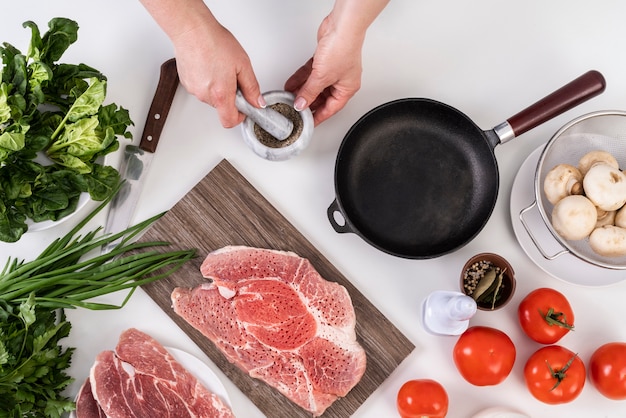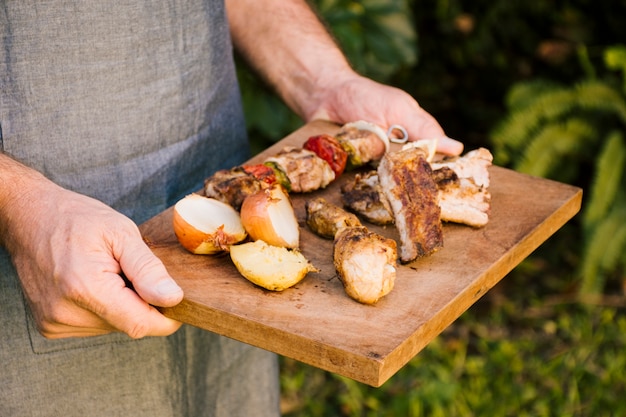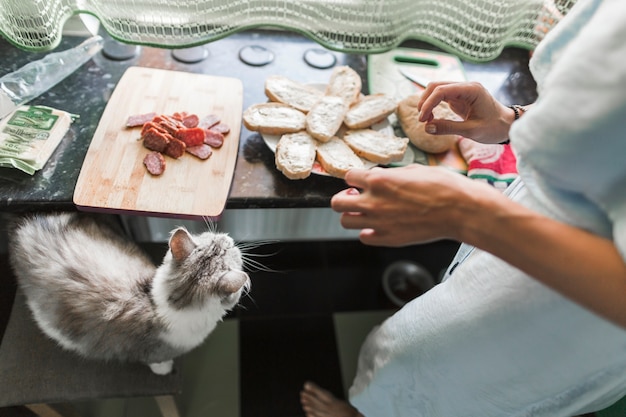Let's be honest, the thrill of the hunt is only half the story. The real joy comes with turning that prize catch into a delicious meal. You've likely already planned the haunch for a roast, the loin for sausages, and maybe the backstraps for a fancy steak. But have you considered the heart? Don't let it go to waste! Venison heart is a real culinary gem, packed with flavor and surprisingly versatile. I'm going to walk you through everything you need to know about preparing and cooking it, from the different cuts and proper handling techniques to some of my favorite recipes. Get ready, folks, we're about to embark on a venison heart adventure!
(Part 1) The Venison Heart: A Culinary Treasure

I've always loved the idea of foraging for my food, bringing home a fresh catch, and enjoying the spoils of a successful hunt. It's about connecting with nature and appreciating the whole animal. Venison heart, unfortunately, is often overlooked. It's a lean, flavorful cut with a texture akin to a firmer liver, and it's brimming with protein and iron. This forgotten treasure deserves a place on our plates, and I'm here to show you why.
The Anatomy of a Deer Heart
Don't picture a simple blob of meat. The heart has distinct parts, each ideal for different cooking methods.
- The Ventricles: These are the large, muscular sections, perfect for slow cooking methods like braising. They'll become incredibly tender and juicy.
- The Atria: The smaller chambers at the top of the heart. These can be cut into smaller pieces for stir-fries, stews, or even added to pasta dishes. Their smaller size allows for quicker cooking.
- The Valves: These are the tough, fibrous tissues that regulate blood flow. They're best discarded as they don't cook well and can be chewy and unpleasant. You'll find these attached to the inner chambers of the ventricles.
Now, you might be thinking, "This seems a bit complicated!" But trust me, it's easier than you think. Once you have your venison heart in hand, you'll see how straightforward the process is. I always recommend breaking it down into smaller pieces before cooking, making it easier to handle and ensuring even cooking.
(Part 2) Preparing the Venison Heart

Time to roll up our sleeves and get our hands dirty! The first step is to rinse the heart thoroughly under cold water to remove any lingering blood or debris. Now, using a sharp knife, we'll remove the valves and the tough outer membrane. This is actually quite simple; you'll spot the membrane clearly surrounding the heart, and it peels off easily. Just be gentle and avoid tearing the meat.
How to Remove the Valves
The valves, those thin, fibrous strands, attach to the inside of the ventricles. You can usually see them clearly and with a gentle tug, they'll come right off. You can also cut them out with your knife, but I find it easier to pull them out. Just be mindful not to tear the meat while you're doing this.
Tips for Slicing and Dicing
Once the valves and membrane are gone, it's time to slice or dice the heart according to your chosen recipe. For braising or slow cooking, larger chunks are perfect. If you're aiming for a stir-fry, stew, or pasta dish, smaller pieces will be best. I find it helpful to first cut the ventricles into thick slices, then dice those into cubes. This ensures consistent-sized pieces for even cooking.
You can also trim off any excess fat. Venison heart is naturally lean, so you don't have to be overly zealous, but if you prefer a leaner meat, feel free to trim it away.
(Part 3) Marination Magic

Now for the fun part! While venison heart has its own delicious flavour, it's quite neutral, making it a blank canvas for the flavours you choose to impart. This is where the magic of marinades comes in.
My Favourite Marinade
I like to keep things simple. My go-to marinade is a blend of olive oil, red wine vinegar, garlic, rosemary, and a touch of salt and pepper. This combination brings out the earthy sweetness of the heart and adds a touch of tangy zest. But feel free to customize to your heart's desire (pun intended!). A pinch of cayenne pepper for a bit of heat, or a splash of Worcestershire sauce for a richer depth of flavour, are just two possibilities. The key is to ensure the marinade has enough time to penetrate the meat. I usually let it sit for at least 30 minutes, but overnight is even better for a deeper flavour infusion.
Other Marinade Ideas
Don't be afraid to experiment! A tangy citrus marinade with lemon, orange, and fresh herbs will add a vibrant brightness. Or, for something more earthy, try a marinade with soy sauce, ginger, and garlic. Let your creativity run wild and discover your favourite flavour combinations.
(Part 4) Cooking with Venison Heart
Now we're ready to heat things up! Venison heart is surprisingly versatile, lending itself to a variety of cooking methods. Your choice will depend on the specific cut of meat you're using and the desired final texture.
Braising: Slow and Steady Wins the Race
Braising is my absolute favorite way to cook venison heart. It's a gentle, low-and-slow method that transforms the heart into a tender, juicy masterpiece. To braise, brown the heart in a hot pan with some oil, then transfer it to a dutch oven or other oven-safe pot. Add some liquid, such as wine, broth, or even water, and let it simmer in the oven until it's cooked through and fork-tender. Braising is particularly well-suited to the larger ventricles, allowing their rich flavors to fully develop.
Quick Frying: A Speedy Supper
Short on time? Quick frying is a great option. Cut the heart into cubes and sear them in a hot pan with some oil until they're browned and cooked through. They're perfect for adding to a stir-fry, stew, or pasta dish, providing a hearty and flavorful addition. This method works well for the smaller atria, as they cook quickly and absorb flavors readily.
Other Cooking Methods
Don't limit yourself! Venison heart can be grilled, roasted, or even smoked. Just remember to adjust the cooking time based on the method and the thickness of the meat. For example, grilling will require a higher heat and shorter cooking time compared to braising.
(Part 5) Venison Heart Recipes: From Simple to Spectacular
Now it's time for some inspiration! I'm going to share two of my favorite venison heart recipes, one simple and one a little more adventurous.
Recipe 1: Simple Braised Venison Heart
This is a classic, easy-to-follow recipe perfect for a weeknight dinner, and so delicious you'll want to make it again and again.
- Ingredients:
- 1 venison heart, trimmed and cut into large chunks
- 1 tablespoon olive oil
- 1 onion, chopped
- 2 carrots, chopped
- 2 celery stalks, chopped
- 1 cup red wine
- 1 cup beef broth
- 1 bay leaf
- 1 teaspoon dried thyme
- Salt and pepper to taste
- Instructions:
- Heat the olive oil in a large Dutch oven or oven-safe pot over medium heat.
- Add the venison heart and brown it on all sides.
- Remove the heart from the pot and set aside.
- Add the onion, carrots, and celery to the pot and cook until softened, about 5 minutes.
- Add the red wine, beef broth, bay leaf, and thyme to the pot. Bring to a boil, then reduce the heat to low.
- Return the venison heart to the pot. Cover the pot and cook in a preheated 350°F oven for 2-3 hours, or until the heart is fork-tender.
- Remove the venison heart from the pot and shred it using two forks.
- Serve the venison heart over mashed potatoes or polenta.
- Ingredients:
- 1 venison heart, trimmed and cut into cubes
- 1 tablespoon olive oil
- 1 onion, sliced
- 1 red bell pepper, sliced
- 1 cup broccoli florets
- 1/2 cup snow peas
- 1/4 cup soy sauce
- 2 tablespoons honey
- 1 tablespoon rice vinegar
- 1 teaspoon grated ginger
- 1 clove garlic, minced
- Salt and pepper to taste
- Instructions:
- Heat the olive oil in a large skillet or wok over medium-high heat.
- Add the venison heart and cook until browned on all sides, about 5 minutes.
- Remove the heart from the skillet and set aside.
- Add the onion, red bell pepper, broccoli, and snow peas to the skillet and cook until the vegetables are crisp-tender, about 5 minutes.
- In a small bowl, whisk together the soy sauce, honey, rice vinegar, ginger, and garlic.
- Pour the sauce mixture over the vegetables in the skillet.
- Return the venison heart to the skillet and cook until heated through, about 2 minutes.
- Serve over rice or noodles.
Recipe 2: Venison Heart Stir-Fry with Asian Flavours
This recipe is a bit more adventurous, with a burst of Asian flavors. It's quick and easy to make, perfect for using up leftover venison heart.
(Part 6) Storage and Leftovers
Now, let's talk about keeping that venison heart fresh and delicious. If you're not planning to cook it right away, store it in the refrigerator for up to 3 days. Wrap it tightly in plastic wrap or place it in a sealed container. For longer storage, you can freeze it for up to 3 months. Wrap it tightly in plastic wrap, then place it in a freezer-safe bag. This will help to prevent freezer burn and maintain its quality.
Leftover Magic
Leftovers are a culinary treasure in themselves! Venison heart is incredibly versatile and can be used in a variety of dishes. It's fantastic in stews, soups, and even salads, adding a hearty, gamey flavor. Just remember to reheat it thoroughly before serving.
(Part 7) Venison Heart: A Taste of the Wild
I'm a bit of a traditionalist when it comes to venison heart, I must admit. I love the simplicity of braising it in a red wine and broth sauce, letting the natural flavors shine through. But I also enjoy venturing outside my comfort zone, and I've found that venison heart readily accepts a wide range of flavors, from earthy and rustic to spicy and exotic.
One of the things I love most about cooking venison heart is its sustainability. It's a fantastic way to use every part of the animal, and it's a healthy, flavorful choice. If you're looking for a new way to enjoy wild game, give venison heart a try. It's sure to become a favorite, especially with its surprisingly affordable price.
(Part 8) FAQs
I know you might have some questions, so let's address a few commonly asked ones:
1. Is venison heart safe to eat?
Absolutely! Venison heart is perfectly safe to eat, as long as it's been properly handled and cooked. The key is to cook it to an internal temperature of at least 160°F (71°C) to kill any bacteria. A meat thermometer is your best friend here!
2. What does venison heart taste like?
Venison heart has a rich, gamey flavor that's reminiscent of beef, but with a slightly more intense and earthy note. It's also very lean and has a firm texture that's a bit like a firmer liver.
3. How can I tell if venison heart is fresh?
The best way to tell if venison heart is fresh is to look at its color. Fresh venison heart should be a deep red or purple color. It should also be firm to the touch and free from any unusual smells or discoloration.
4. Can I substitute beef heart for venison heart in a recipe?
You can, but keep in mind that beef heart has a slightly different texture and flavor. You may need to adjust the cooking time and seasoning accordingly.
5. Is venison heart good for you?
Absolutely! Venison heart is a good source of protein, iron, and other essential nutrients. It's also low in fat and calories, making it a healthy choice.
There you have it! I hope this guide has equipped you with the confidence to tackle venison heart yourself. It's a delicious and versatile cut of meat that's perfect for a variety of dishes. So get out there, experiment, and let me know what you think! Happy hunting (and cooking!)
Everyone is watching

Prime Rib Roast Cooking Time Chart: Per Pound Guide
Cooking TipsPrime rib roast. Just the name conjures images of lavish dinners, crackling fires, and hearty laughter. It’s ...

How Long to Bake Potatoes in the Oven (Perfect Every Time)
Cooking TipsBaked potatoes are a staple in my kitchen. They're incredibly versatile, delicious, and surprisingly easy to m...

Perfect Rice Every Time: The Ultimate Guide to Cooking Rice
Cooking TipsAs a self-proclaimed foodie, I've always been a bit obsessed with rice. It's the foundation of countless cuisi...

The Ultimate Guide to Cooking Asparagus: Tips, Techniques, and Recipes
Cooking TipsAsparagus. The mere mention of this spring delicacy conjures up images of vibrant green spears, crisp and burs...

Ultimate Guide to Cooking the Perfect Thanksgiving Turkey
Cooking TipsThanksgiving. Just the word conjures up images of overflowing tables laden with delicious food, the scent of r...
